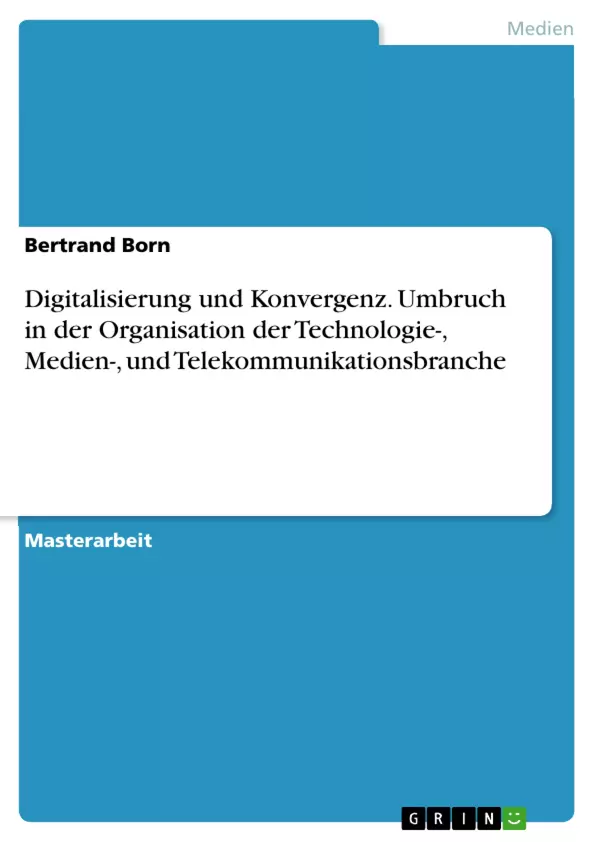Die Digitalisierung hat Medieninhalte und deren Übertragung in hohem Masse standardisiert. Dies führt zu einem radikalen Umbruch und der Verschmelzung traditionell getrennter Wertschöpfungsketten.
Der Autor untersucht Anhand von Internet-Theorie (z.B. Long Tail, Tipping Point, Network Effects, Digital Ecosystem) und Organisations- und Transaktionskosten-Theorie die Folgen dieser Konvergenz auf die Organisation von Unternehmen der Technologie-, Medien-, und Telekommunikationsbranchen. Anhand von Fallbeispielen aus der Praxis zeigt er auf, wie Unternehmen sich verändern, um mit dem Digitalen Wandel Schritt zu halten.
Inhaltsverzeichnis
- EINLEITUNG
- UNTERSUCHUNGSGEGENSTAND UND FORSCHUNGSLEITFRAGEN
- METHODIK UND VORGEHENSWEISE INNERHALB DER ARBEIT
- GESTALTUNG UND EINFLUSSGRÖßEN DER ORGANISATION
- DIE ROLLE DER ORGANISATION IM UNTERNEHMEN
- GESTALTUNG DER ORGANISATION
- Organisatorische Differenzierung
- Organisatorische Integration
- Gliederungsprinzipien — Funktion und Objekt
- Koordinationsinstrumente
- EINFLUSSGRÖßEN DER ORGANISATION
- Transaktionskosten und Koordinationsformen
- Markt Koordination
- Koordination durch Hierarchie
- Hybrid Koordination
- Kontingenztheoretischer Ansatz
- Umwelt — Komplexität, Dynamik, Unsicherheit
- Fertigungs- und Kommunikationstechnologie
- Strategie
- Faktorspezifität und Abhängigkeit
- FORMEN DER KONVERGENZ
- TECHNOLOGISCHE KONVERGENZ
- Inhalteformate
- Distributionsnetze
- Endgeräte
- REZEPTIVE KONVERGENZ
- WIRTSCHAFTLICHE KONVERGENZ
- KONVERGENZ UND DIE ORGANISATION DER TMT-UNTERNEHMEN
- DIE UNTERNEHMEN DER TMT-BRANCHE
- Medienunternehmen
- Netzbetreiber
- IT-und Consumer Electronics Unternehmen
- VERÄNDERUNG ORGANISATORISCHER EINFLUSSGRÖßEN DURCH KONVERGENZ
- Umwelt — der Long Tail Effekt
- Fertigungs- und Kommunikationstechnologie - Digitalisierung
- Strategie — digitale Ökosysteme und Netzwerkeffekte
- Faktorspezifität und Abhängigkeit — Standards, Module und Systeme
- BRANCHENSPEZIFISCHE EFFEKTE DER KONVERGENZ
- Medienunternehmen
- Netzbetreiber
- IT- und Consumer Electronics Unternehmen
- Effekte auf die Gesamt-Wertkette der TMT-Märkte
- FALLBEISPIELE AUS DER PRAXIS
- MEDIENUNTERNEHMEN — AXEL SPRINGER AG
- NETZBETREIBER — DEUTSCHE TELEKOM AG
- IT- UND CONSUMER ELECTRONICS UNTERNEHMEN — SONY
- FAZIT, EVALUATION UND AUSBLICK
- FAZIT
- EVALUATION — ANFORDERUNGEN AN DIE ORGANISATION
- AUSBLICK
- ANHANG
- QUELLENVERZEICHNIS
Zielsetzung und Themenschwerpunkte
Die Arbeit untersucht die Auswirkungen der Konvergenz von Informationstechnologie, Medien und Telekommunikation auf die Organisation von Unternehmen in der TMT-Branche. Ziel ist es, die Veränderungen der Organisationsstrukturen und -prozesse durch Digitalisierung und die Zusammenführung verschiedener Wertschöpfungsstufen zu analysieren.
- Die Rolle der Organisation im Unternehmen und ihre Gestaltungselemente
- Die verschiedenen Formen der Konvergenz (technologisch, rezeptiv, wirtschaftlich)
- Die Auswirkungen der Konvergenz auf die Einflussgrößen der Organisation (Umwelt, Technologie, Strategie, Faktorspezifität)
- Die branchenspezifischen Effekte der Konvergenz auf Medienunternehmen, Netzbetreiber und IT-/CE-Unternehmen
- Die Herausforderungen und Chancen für die Organisation von Unternehmen in der TMT-Branche
Zusammenfassung der Kapitel
Die Arbeit beginnt mit einer Einführung in den Untersuchungsgegenstand und die Forschungsleitfragen. Anschließend werden die theoretischen Grundlagen der Organisation allgemein erörtert, wobei die Rolle der Organisation im Unternehmen, ihre Gestaltung und ihre Einflussgrößen im Fokus stehen. Die theoretischen Erkenntnisse werden dann auf die TMT-Unternehmen übertragen.
Im dritten Kapitel wird das Phänomen der Konvergenz in seinen verschiedenen Ausprägungsformen (technologisch, rezeptiv, wirtschaftlich) untersucht.
Kapitel 4 analysiert die Auswirkungen von Konvergenz auf die Organisation von TMT-Unternehmen. Zunächst wird die TMT-Branche definiert und die Unternehmen der Teilbranchen Medien, Telekommunikation und IT/CE vorgestellt. Anschließend werden die Effekte von Konvergenz auf die allgemeinen Einflussgrößen der Organisation untersucht, um hieraus die TMT-branchenspezifischen Effekte der Konvergenz herzuleiten.
Kapitel 5 validiert die theoretischen Erkenntnisse anhand von Fallbeispielen aus der Praxis: Axel Springer AG, Deutsche Telekom AG und Sony Corporation.
Die Arbeit schließt mit einer Zusammenfassung der Ergebnisse, einer Evaluation von Methodik und Befunden und einem Ausblick über mögliche Zukunftsentwicklungen.
Schlüsselwörter
Die Schlüsselwörter und Schwerpunktthemen des Textes umfassen die Digitalisierung, Konvergenz, TMT-Branche, Organisation, Medienunternehmen, Netzbetreiber, IT- und Consumer Electronics Unternehmen, Transaktionskosten, Kontingenztheorie, Netzwerkmarkt, digitale Ökosysteme, Long Tail Effekt, Hybrid Koordination, Vertikale Integration, Standardisierung, Modularisierung und Ubiquität.
- Quote paper
- Bertrand Born (Author), 2013, Digitalisierung und Konvergenz. Umbruch in der Organisation der Technologie-, Medien-, und Telekommunikationsbranche, Munich, GRIN Verlag, https://www.grin.com/document/265943




